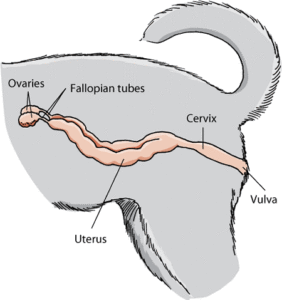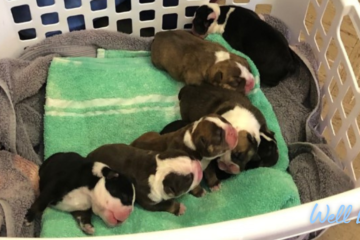I believe that canine reproduction is a team sport. When I’m working with a client, we need to trust each other and to be on the same page every step of the way. For that reason, I believe it’s very important that responsible breeders understand the “why” behind our breeding management decisions. Maybe it’s my background as a high school teacher, but I don’t want my clients to blindly agree to my recommendations. I want them to know WHY. I want them to want to know WHY. I’ve always loved the teaching part of teaching, and that didn’t go away when I became a veterinarian.
In this post, I will provide a basic explanation of the foundation of breeding management in the bitch – anatomy (the structures), reproductive cycle, important hormones, and information we gain from vaginal cytology (looking at cells swabbed from the vagina). Understanding the basics of reproduction illuminates the WHY behind breeding management decisions!
Anatomy
Here’s a list of the basic pieces and parts of the canine female reproductive system –
Vulva* – the external opening to the vagina
Vagina – the passageway between the vulva and the cervix
Cervix – the “gateway” between the vagina and the uterus
Uterus – where the puppies grow, the uterus is V-shaped and branches into two “horns”
Ovaries – the source of eggs; when an ovary ovulates, it releases eggs into the oviduct
Oviduct – the passageway between the ovary and the uterus; aka fallopian tube or uterine tube

Source: Merck Veterinary Manual
* Soapbox moment: It drives me crazy when people use the word “vagina” to refer to a vulva. You cannot see the vagina if you’re looking at the exterior of the body. The vagina is the tunnel and the vulva is the entryway. Imagine how confusing it would be if every time people needed to talk about their hand they used the word “arm” instead. Yes, they’re next to each other, but they’re completely different anatomic structures with different functions! Join me in my mission to use the word vulva correctly!
Reproductive Cycle
During the majority of the year, the female canine reproductive tract is mostly inactive. The uterus is small and has a low volume of blood flow directed to it. The ovaries are small and not ovulating.
When the bitch comes into heat, bloodflow increases to the uterus and she develops a bloody discharge. How much discharge and exactly how bloody it is varies from individual to individual. At this stage, she is usually NOT receptive to the male (although some don’t read the book).
After approximately 9-12 days, the discharge becomes lighter both in volume and in color (although, again, some bitches don’t read the book). This happens when progesterone levels start to rise in her bloodstream. Progesterone is a hormone that we can track to identify when she’s ovulated.
At baseline, her progesterone level is very low – close to 0 ng/mL. As her ovaries are getting ready to ovulate, the progesterone level slowly starts to rise. Once the progesterone level reaches approximately 2.0-3.0 ng/mL, her brain will release another hormone, called luteinizing hormone (LH for short). LH essentially “tells” the ovaries to ovulate, but they don’t listen right away. The ovaries ovulate approximately 36-48 hours after the LH surge occurs. At this point, the progesterone level is between 5.0-10.0 ng/mL and rises rapidly. When you’re trying to identify the date of ovulation, the most important factor to look for is a RAPID RISE, not a specific number. There’s additional information about progesterone in this article.
The eggs start traveling down the oviduct, but they are not ready to be fertilized at this point. Instead, it takes approximately 48 hours for them to mature and be able to be fertilized by sperm. Progesterone continues to rise, and it’s important to know that the progesterone is rising normally, but exactly what number the progesterone reaches is somewhat irrelevant.
Vaginal Cytology
One additional diagnostic that your veterinarian may use to manage your bitch’s breeding cycle is vaginal cytology. To collect this sample, the veterinarian passes a swab through the vulva and into the vagina, swapping up some of the vaginal cells. They then roll this swab onto a glass slide, stain them, and look at them under the microscope. As progesterone rises, the type of cells present on the surface of the vagina changes. Essentially, they become a high percentage of “cornified” cells, which in normal canine reproduction help to protect the vagina against friction (i.e. breeding). I like to use both progesterone and vaginal cytology to have additional information if I need a “tie breaker.”
Summary
To recap, canine breeding management has lots of pieces: the physical changes in anatomy, behavior changes, hormone levels, and vaginal cytology. Using all these indicators together can maximize the chances of a successful breeding outcome. Canine reproduction is a team sport, and since you made it to the end of this post, I’m guessing you agree!
Yours in responsibly-bred puppies,



0 Comments